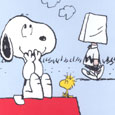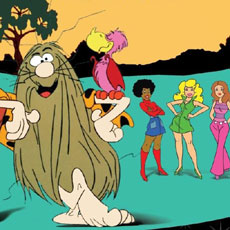Hanna-Barbera (1971), Warner Home Video (March 18, 2008), 2 discs, 319 mins plus supplements, 1.33:1 original full frame ratio, Dolby Digital 1.0 Mono, Not Rated, Retail: $26.98
Storyboard:
Fred and Barney’s kids have grown up, entered high school, and taken on some wacky friends in these family-friendly stone-age stories.
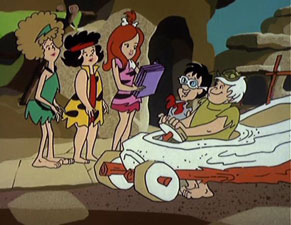
The Sweatbox Review:
The Flintstones was a milestone series for Hanna-Barbera from the moment it debuted in 1960. It would go down in history as television’s first prime time cartoon series, but it was a commercial and ratings success as well. Its initial run went for six years of new episodes, following the lives of two prehistoric families. Although originally a thinly disguised copy of The Honeymooners, by its third season it entered the realm of the family sitcom, with the introduction of Fred Flintstone’s little girl, Pebbles. The Rubbles’ boy Bamm-Bamm followed the next season, and from then on the franchise would be known for its exploration of family dynamics. Hanna-Barbera would later take that a step further with the first of several spin-off shows, The Pebbles And Bamm-Bamm Show.
The original show would be the only version to appear in prime time, excepting specials and movies. The Pebbles And Bamm-Bamm Show premiered in 1971 on CBS, as a Saturday morning program. Sixteen half-hours were produced, focusing on the now teenage children of the Flintstones and the Rubbles. Pebbles and Bamm-Bamm were now attending Bedrock High School, and getting into trouble without the help of their bumbling dads. They had a diverse supporting cast, including their three closest friends— the flaky and astrology-obsessed Wiggy, squeaky-voiced Penny, and erudite inventor Moonrock. The cast also featured Badluck Schleprock, a poor schlimazel whose very presence signalled oncoming calamity; Pebbles’ pretty blonde rival Cindy and her similarly snobby boyfriend Fabian; and of course the adult gang from the original series. Fred, Wilma, Barney, and Betty appeared regularly, often figuring prominently in the plot but never overshadowing the kids.
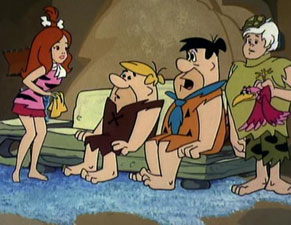
The Pebbles And Bamm-Bamm Show carried on the tone of the latter seasons of The Flintstones. Fred was no longer the loud-mouthed caveman he was in 1960. Instead, he had mellowed into a practically mild-mannered family man, comfortable in his position at work and satisfied with his place in life. In Pebbles And Bamm-Bamm, he barely raises his voice at all, and rarely argues with Barney. The franchise had lost its edge, but it all seems to be an appropriate progression. After all, if Fred had stayed a bore for all those years, it is likely that Pebbles would have been raised by a single mom. The fact that Fred was able to mature may have meant changing the nature of the franchise, but it’s a comforting change in a way.
And besides, Pebbles And Bamm-Bamm was a Saturday morning show, and as such needed to be a quieter, gentler program. It’s still plenty of fun to watch, though, with just enough conflict between the characters to keep things interesting. Pebbles and Bamm-Bamm stay on good terms generally, showing themselves to be positive role models of adolescent love; but the iciness between Pebbles and Cindy is palpable, while it is clear that the gang has decidedly negative feelings about poor ol’ Schleprock. Moonstone is a little full of himself, but stops just short of being a jerk. Then there’s the Bronto Bunch, a motorcycle gang that often antagonizes the main group of kids, though in a fairly non-threatening way.

As I started viewing the set, I grew a bit concerned. Gridiron Girl Trouble starts out as a fairly boring dog catcher story, but as the title suggests it becomes a fun story of Pebbles joining the school football team. OK, it’s not the most original plot ever, but the execution is fun. The rest of the episodes follow a similar pattern, with Pebbles having some well-meaning scheme backfire, only to be replaced by another well-meaning scheme. Bamm-Bamm and the rest of Pebbles’ friends show varying levels of enthusiasm for the plans, usually in proportion to how likely they are to succeed. Bamm-Bamm is usually the most levelheaded of the bunch, though his affection for Pebbles will sometimes cloud his judgement.
Whether it be a tale of Pebbles hunting a snorkosaurus (The Terrible Snorkosaurus) trying to save her dad’s job (Daddy’s Little Helper), or helping Badluck Schleprock change his luck (Schleprock’s New Image), the stories are told good-naturedly and with a solid dose of humor. Pebbles, despite her penchant for fouling up and getting into trouble, is fully endearing. Bamm-Bamm rarely displays his babyhood super-strength, but this has been replaced by a strength of character that makes it easy to see why Pebbles is so fond of him.

Scooby-Doo vets Ken Spears and Joe Ruby were story editors on the show, insuring a high level of quality. Whoever came up with Pebbles’ adorable catch phrase “Yabba Dabba Doozie!” deserves an award. Production design was done by one of the best around, Iwao Takamoto. I’m not sure if the character designs were exclusively his, but I have always admired them. Moonrock is a favorite, with that big red bowtie and bone clip, Penny is totally cute, and Schleprock is just a classic.
As with other Hanna-Barbera shows of this era, the line weights are lighter, and characters wander off-model frequently in some episodes. While this happened in the fist season of The Flintstones too, it seemed more endearing then, and even the mistakes still looked like solid cartooning. Here, when characters go off-model, it just looks bad. Fortunately, it’s only an issue in a few episodes.

So whatever happened to Pebbles and Bamm-Bamm? Well, this particular version of them was never seen again, other than in episodes of the next couple of versions of The Flintstones, which mainly relied on re-airing the same Pebbles And Bamm-Bamm episodes. Later spin-offs and specials would revert to seeing the kids as babies, or even pre-teens (like in The Flintstones Little Big League, 1978). However, they did show up again as adults in a pair of 1983 prime time movies on ABC, where they married and had twins.
Is This Thing Loaded?
Unfortunately, there is little to say in this section. The first disc has Trailers for the new Horton Hears A Who DVD and the Smurfs set, plus more trailers that can be selected from the menus, including three for Flintstones season sets (Two through Four), and Warner’s recent Academy Awards shorts collection.

The only real extra hardly feels like an extra since it is… more Pebbles And Bamm-Bamm episodes! However, these are the four stories done for the successor show, The Flintstones Comedy Hour (1972). Each of these is only half as long as the full-episode stories that make up most of the set. The first two here are grouped together, and run with the opening and closing for The Pebbles And Bamm-Bamm Show, while the other two have the openings and closings for a later spin-off, The Flintstones Comedy Show (1973; yes, all these spin-offs get confusing). Regardless, the quality of these is the same as the rest of the set, with stories that concern Moonstone’s walkie talkie being swallowed by an animal, which makes Fred think it’s eaten Barney; a dating machine, that matches all the kids up in funny ways; a masquerade party where Cindy and Fabian dress the same as Pebbles and Bamm-Bamm; and a sort-of take-off on the Orson Welles War Of The Worlds radio broadcast.

(Fans may recall that The Flintstone Comedy Hour also had sequences featuring Pebbles and Bamm-Bamm and their fiends singing songs as The Bedrock Rockers, but these were not included in this set.)
Case Study:
Warner continues to have fun with the trade dress on these Hanna-Barbera Classic Collection sets. This time, the slipcase sports a colorful animal skin design. Inside, an altered image of the front cover appears over the digipack. This is an ultra-slim release, with two overlapping discs inside, and nice artwork all-around.

Ink And Paint:
Some of these episodes actually look pretty good, but then there are others that confirm that little to no restoration work was done. Those episodes have numerous scratches, pink skin tones, and prominent video noise. Even the best episodes have that typical Hanna-Barbera” dirty” look, with numerous smudge marks and cel dust.

Scratch Tracks:
The single channel mono sound is quite adequate, and suits the show nicely. I was a little surprised to hear a laugh track, but that was typical of the time. Only English audio and subtitles are offered. Listening to the show, one can enjoy many of the same musical cues that graced The Flintstones, offering a nice sense of continuity (although, of course, the same music often appeared on other Hanna-Barbera shows as well!). Additionally, one can hear a number of familiar voices. Alan Reed was still voicing Fred at this time, and Wilma was still being performed by Jean Vander Pyl. Mel Blanc was on hand for Barney and incidental voices. Sally Struthers and Jay North, both names that should be familiar to TV sitcom buffs, did Pebbles and Bamm-Bamm. Mickey Stevens replaced Sally Struthers in the Flintstones Comedy Hour episodes.
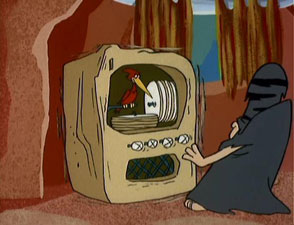
Final Cut:
The Pebbles And Bamm-Bamm Show was a worthy follow-up to The Flintstones, offering fun and creative stories with appealing characters and positive virtues. Those who feel that it lost too much of the edge from its predecessor may be reminded that that edge was slipping years earlier, once Fred became a family man. The focus here is on the kids anyways, and I think the cast of crazy teens is just as appealing as those from the Archie crew. If you love the world of The Flintstones, you can rest assured that this is one of the better spin-offs.
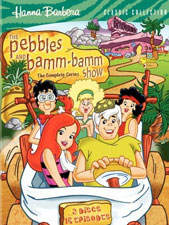 | ||
 |






